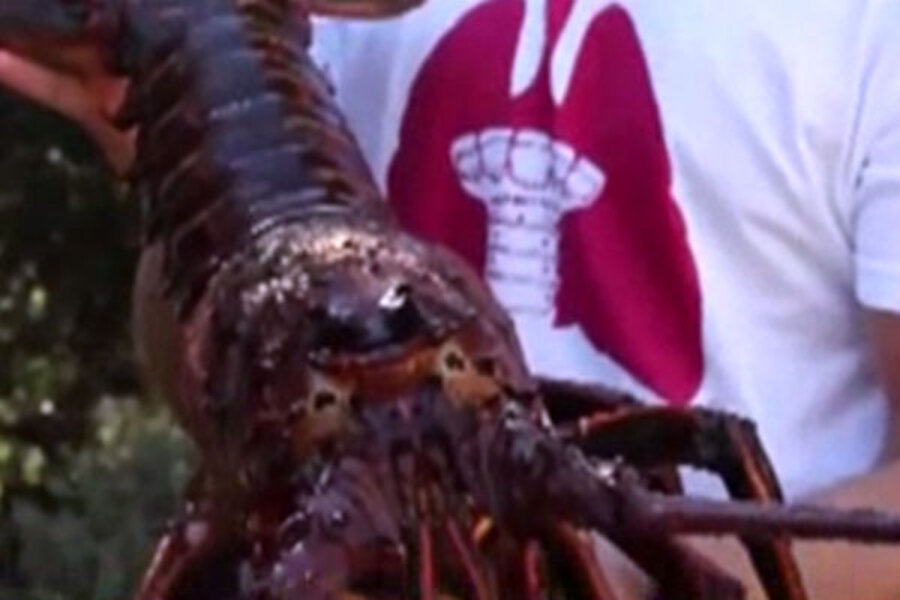Dinner or pet? What not to name the lobster if you intend to eat it
Loading...
Forrest Galante of Santa Barbara, California just learned what many parents already know about lobster dinners – that it’s almost impossible to eat something you or your child has named.
Parents know that before you have kids it’s just a lobster, and after kids it’s a new friend to whom you might sing Little Mermaid songs.
However, Mr. Galante is not a father or known for being a Little Mermaid movie, singing lobster kinda guy, but rather is best recognized for having appeared on Discovery Channel’s survival reality show “Naked and Afraid.”
Still, Galante recently showed his papa-potential by sparing one fortunate lobster.
He caught the massive 12-pound Pacific Spiny lobster near Anacapa Island off the coast of California in the middle of the night, according to an interview with KEYT TV, promptly named it Albert Gerther.
Asked why he picked that particular name, Galante replied in Facebook chat today that he, “just named him something that I thought was hilarious and had the word ‘girth' in it due to his tremendous size.”
So began anthropomorphization of the crustacean I now prefer to think of as Big Al, who went home to Galante’s place for what was meant to be a once-in-a-lifetime lobster dinner.
During an interview with Galante about his catch, the news show rolled footage from the night fishing expedition of the enormous crustacean spreading it’s many legs in what looked like an attempted embrace of his captor.
“Just didn't want to kill something that special that is 3x my age for a 1 time meal,” Galante wrote in a Facebook chat session Friday. “I'm a biologist and understand the importance large genetics in the gene pool, was much happier to see him go back.”
Galante also told his television interviewer about the change of heart which occurred after the lobster was home and dry.
“Anything that can bear hug a man like that is pretty big, man,” he told the television interviewer. “There was just no way I could kill it for a one-time meal. I rushed him down to the Sea Center and they got him into a tank.”
The sea center that Galante was referring to is the Santa Barbara Museum of Natural History Sea Center.
He added in our Facebook chat, when asked about returning him to the sea center, “Ha, yeah I suppose after making the decision not to eat him I did feel quite bonded to him and was most interested in his well being!”
The moment when I knew Galante’s daddy potential was clear was when he told the TV interviewer, “It was interesting to see how all the smaller lobsters flocked to him so he could protect them.”
I have made the mistake myself, as have my own parents, of looking a living lobster in the beady eye, naming it as part of the family dinner, only to have it backfire and end up eating cereal that night with our expensive new “pet.”
My mom tells the tale of how she and my father once brought home a live lobster to our New York City apartment when I was a toddler. Apparently the crusty critter wriggled free of the tongs my father held instead of being dropped into the pot of boiling water, and hit the floor before skittering away.
“It got behind the refrigerator and your father had to move the fridge and use a broom to get it out,” my mom, now 84, recalls. “You were crying. I was up on a chair. That’s why we never cooked lobster again at our house. Too traumatic.”
My husband and I had cooked lobsters B.C. (Before Children) without incident.
However, any time we attempted to cook one after that, one of our four boys was quick to name every single one and thereby force a release to the nearest ocean.
Recently, my son Zoltan, now in college, asked me in a chiding tone, “How come we never cooked lobster? I love it.”
After a few moments of looking like a chagrinned Daffy Duck, I told him that he loves it “now,” but not when it was named “Lazlo” or “Clawson.”
Zoltan is responsible for turning our home vegetarian for a year after his second grade class went to visit a dairy farm when we lived in New Jersey.
“They’re so soft and they have names,” little Zoli wailed at McDonalds. “We can never eat any animal again!”
“Never” lasted a year until he discovered how good burgers smell on a grill during a friend’s birthday party.
So when my son chided me for our lack of lobster on the family table over the years, I invoked the parental words of doom saying, “Someday, I hope your kids name their lobsters! Come back and see me then!”






